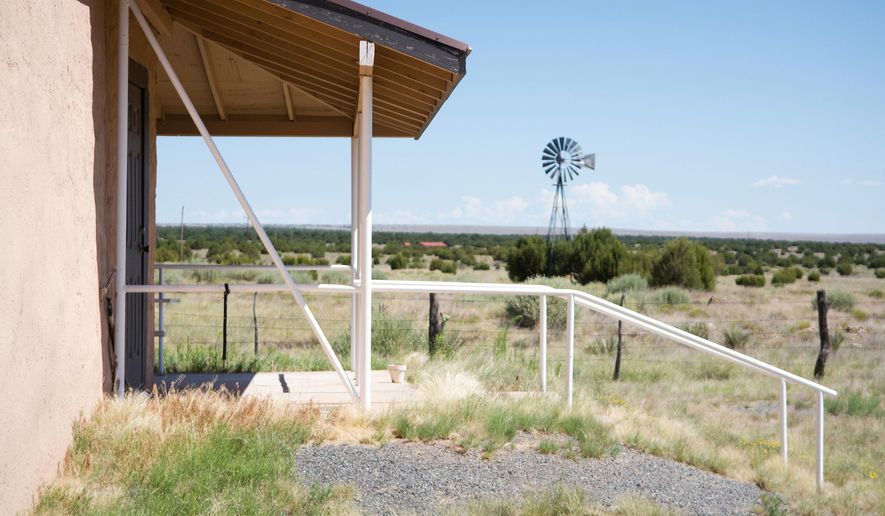ALBUQUERQUE, N.M. (AP) - Wind rattles the rusted metal roof of a half-collapsed adobe house, grasses wave in the small churchyard and the crude lettering on a weathered gravestone reveals it belongs to a young child, telling the exact lifespan in months and days.
Pinos Wells had a short lifespan, too.
The Torrance County ranching community southeast of Estancia once had its own post office, a school, stores and a hotel that offered food, water and lodging to travelers from White Oaks bound for Santa Fe. It was there, in the years shortly before New Mexico gained statehood, that a high-profile politician was shot to death, reported the Albuquerque Journal (https://bit.ly/2aJjSEg ).
Like many other New Mexico ghost towns, the population of Pinos Wells, never more than a few hundred, gradually fell victim to drought, the Depression and the lure of city jobs.
But on a recent weekend, as it has for decades, the village sprang to life when more than 100 former residents, their children, grandchildren and friends flocked home to celebrate the Fiestas de San José, for whom the church is named.
“They feel allegiance because of the church and their families that lived here,” said 84-year-old Manny Romero, a local historian.
They come from places like Albuquerque, Los Lunas, Belen, Willard, Manzano, Estancia, Chilili and Vaughn. Many arrive with trailers and camp out for several days. It’s the same every year; they visit, reminisce and share stories. The children play, the men do maintenance work on the church and the women prepare for the fiesta’s Mass and the celebrations that follow.
“It’s like a big family reunion with a potluck dinner,” said former resident Lisa Abeyta, president of the Sacred Heart Society that helps organize the fiestas.
Last families
This year marks the 105th anniversary for the tiny church that stands proud among the crumbling remains of the former village. Its walls are recently stuccoed, its metal roof is shiny, and a large covered porch with benches and tables serves for the celebrations that follow the fiesta Mass.
“The church in Pinos Wells is the glue that revives Pinos Wells every year,” said Romero.
The Rev. Christopher Bernabe planned to come from Vaughn, about an hour’s drive away, to celebrate Mass and baptize two of Abeyta’s grandchildren.
She ventured that it was the first baptism Pinos Wells has seen in about 50 years. Abeyta, 54, lived in the village until she was 17.
“We were some of the last families. In 1978 our house burned down. We lived on with my grandfather a while longer, then we moved to Vaughn. Then pretty much everyone moved,” Abeyta said.
Many of the Pinos Wells area ranchers took railroad jobs in Vaughn or at a rock quarry near Encino, she said.
Bernadette Gallegos, 53, and her five siblings lived in Pinos Wells until 1972 when her family moved to Vaughn. She remembers a bus coming to pick up the village children and take them to school in Encino, a town a few miles away. Pinos Wells’ own school closed in the 1940s.
Gallegos and her extended family members come back to the village every year.
“My parents are buried there,” Gallegos said. “We feel their spirit and their presence there.”
Romero grew up in Estancia but he remembers going to dances and fiestas in the small villages east of the Manzano Mountains like Tajique and Torreon.
The Fiestas de San José in Pinos Wells was a big, big thing, he said.
“When we were growing up they always had dances. There was music, they put up a tent - oh, yeah - that was big time entertainment for us growing up. That was how we met the girls,” Romero said.
Romero still goes to the Pinos Wells fiestas, though nowadays it’s all about getting together with old friends.
Changing world
The land around the village is flattish grassland, home to white-tailed deer and meadowlarks. A salt pan is visible to the northeast. An advertisement in the Journal in 1925 said there was interest in oil drilling around Pinos Wells and nearby Cedarvale. Romero said ranchers of the area were raising cattle and sheep and growing pinto beans and corn when he was young, but that changed.
“During the war people were drafted. After the ‘40s people started moving away. There was no work. People moved to Albuquerque and other towns,” Romero said.
According to Romero’s self-published “History of Torrance County,” Antonio Adan Salas was among the first settlers in Pinos Wells in the late 1890s. Salas had two wells near a couple of pine trees, which gave the town its name. It became a stop on the Santa Fe Trail because it had a reliable source of water. At one time there were two stores, two saloons, a rooming house and a post office.
___
Information from: Albuquerque Journal, https://www.abqjournal.com




Please read our comment policy before commenting.